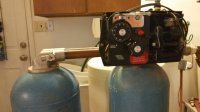pho
New Member
Thank you for all the advices given to me for my recent thread about the resin spilling out of my Culligan.
It works fine now with the new resin.
I've a while ago a dual tank WS from our rental house. It belong to the previous owner. Seems like a Flex 9000 with 2 tanks size 8"* 44" each.
I've not hooked water yet and the control seems to work fine.
I've few questions:
1) How could I remove the control from the tank so the media could be replaced ? Using a large plumber wrench ? How could I hold the tank in place ? Removing the control from the Culligan is so easy with a clamp hold by 2 screws.
2) I plan to convert the WS into a sediment filter or carbon filter by changing the media and removing the pins on the control wheel to disable the brine cycle. Is it possible ?
3) With my water usage of 200 per day, if I use the carbon media, how often should I replace it ? I could not believe when people says about every 5 years. How could the backwash rejuvenate the carbon media ?
4) Any recommendation for sediment and carbon media brand ?
5) Should it be installed before or after the WS ?
I've a Pura Big Boy filter 20"*5". The 10 mic filter is greenish only after a few months of usage from the lake water. and still let lot of sediment/algea going into the house . My water goes thru a sand filter (used in pool) and sit for 1 day for gravity sedimentation before going into the Pura filter.
6) I guess the Big boy pura filter is only 10gpm. When my powerful 2hp booster pump pushes water thru the filter into the pressure tank, the flow could be too big so the sediments are carried too. My design is to have cleaner water into the pressure tank but I think it could be better for the filter location to be after the pressure tank.
It works fine now with the new resin.
I've a while ago a dual tank WS from our rental house. It belong to the previous owner. Seems like a Flex 9000 with 2 tanks size 8"* 44" each.
I've not hooked water yet and the control seems to work fine.
I've few questions:
1) How could I remove the control from the tank so the media could be replaced ? Using a large plumber wrench ? How could I hold the tank in place ? Removing the control from the Culligan is so easy with a clamp hold by 2 screws.
2) I plan to convert the WS into a sediment filter or carbon filter by changing the media and removing the pins on the control wheel to disable the brine cycle. Is it possible ?
3) With my water usage of 200 per day, if I use the carbon media, how often should I replace it ? I could not believe when people says about every 5 years. How could the backwash rejuvenate the carbon media ?
4) Any recommendation for sediment and carbon media brand ?
5) Should it be installed before or after the WS ?
I've a Pura Big Boy filter 20"*5". The 10 mic filter is greenish only after a few months of usage from the lake water. and still let lot of sediment/algea going into the house . My water goes thru a sand filter (used in pool) and sit for 1 day for gravity sedimentation before going into the Pura filter.
6) I guess the Big boy pura filter is only 10gpm. When my powerful 2hp booster pump pushes water thru the filter into the pressure tank, the flow could be too big so the sediments are carried too. My design is to have cleaner water into the pressure tank but I think it could be better for the filter location to be after the pressure tank.

